Ο καλύτερος τρόπος να γνωρίσετε την Αργολίδα! Μονοήμερες εκδρομές (με λεωφορείο) στους αρχαιολογικούς χώρους της Αργολίδας (Επίδαυρος, Κόρινθος, Νεμέα, Μυκήνες, Ναύπλιο). Υπάρχει η δυνατότητα να σας συνοδεύει Αγγλόφωνος ή Γερμανόφωνος ξεναγός.
Επίδαυρος
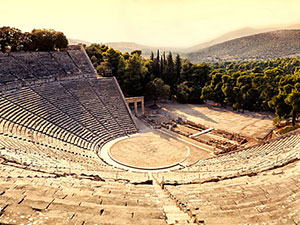
Η στρατηγική της θέση, αλλά κυρίως, το Ασκληπιείο, συντέλεσαν, ώστε η πόλη να γνωρίσει πρωτοφανή ανάπτυξη και παράλληλα να κατασκευαστούν πολλά μηνμεία, όπως το θέατρο της Επιδαύρου. Το θέατρο της Επιδαύρου ξεχωρίζει για την μοναδική του συμμετρία και ομορφιά αλλά και για την απίστευτη ακουστική του. Το θέατρο κατασκευάστηκε από τον Πολύκλειτο τον νεότερο τον 4ο αιώνα προ Χριστού. Αρχικά αποτελούνταν από 34 σειρές αλλά επεκτάθηκε κατα την Ρωμαϊκή Εποχή κατα 21 σειρές επιπλέον. Όπως συνηθίζεται στα αρχαία Ελληνικά θέατρα η ύπαρξη ενός φυσικού τοπίου πίσω από την σκηνή του θεάτρου αποτελεί αναπόσπαστο μέρος του ίδιου του θεάτρου και δε πρέπει να περνά απαρατήρητη. Το θέατρο έχει χωρητικότητα 14.000 ατόμων και θεωρείται το πιο διάσημο θέτρο του κόσμου.
Κύριο χαρακτηριστικό του θεάτρου είναι η εξαιρετική του ακουστική η οποία επιτρέπει την κατανόηση των λεγόμενων των ηθοποιών, από όποιο σημείο και αν βρίσκεται ο θεατής, ακόμα και όταν το θέατρο είναι πλήρες. Είναι σύνηθες οι ξεναγοί να ζητούν από τους τουρίστες να στέκονται σε διάφορα σημεία του θεάτρου για να πειραματιστούν και οι ίδιοι με την μοναδική ακουστική της Επιδαύρου.
Corinth
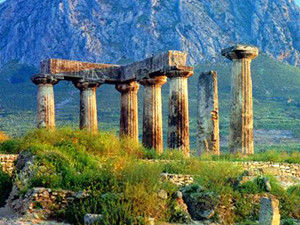
Corinth is the capital of Corinthia and it derives its name from Ancient Corinth, a city-state of antiquity. Since 1896, systematic archaeological investigations of the Corinth Excavations by the American School of Classical Studies at Athens have revealed large parts of the ancient city, and recent excavations conducted by the Greek Ministry of Culture have brought important new facets of antiquity to light.
Ancient Corinth was one of the largest and most important cities of Greece, with a population of 90,000 in 400 BC. After the Romans built a new city in its place and made it the provincial capital of Greece in 44 BC, the city population was between 100,000 to 700,000 according to different sources.
Some of the sites that you can see in Ancient Corinth is: the temple of Apollo, the Fountain of the Owl, the ancient Fountain Peirene, Ruins of Asklepios and many more.
Nemea
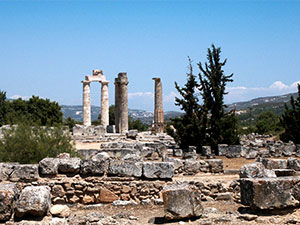
In Greek mythology, Nemea was ruled by king Lycurgus and queen Eurydice. Nemea was famous in Greek myth as the home of the Nemean Lion, which was killed by the hero Heracles,[2] and as the place where the infant Opheltes, lying on a bed of parsley, was killed by a serpent while his nurse fetched water for the Seven on their way from Argos to Thebes. The Seven founded the Nemean Games in his memory, according to its aition, or founding myth, accounting for the crown of victory being made of parsley or the wild form of celery and for the black robes of the judges, interpreted as a sign of mourning. The Nemean Games were documented from 573 BC, or earlier, at the sanctuary of Zeus at Nemea.
Nemea

In Greek mythology, Nemea was ruled by king Lycurgus and queen Eurydice. Nemea was famous in Greek myth as the home of the Nemean Lion, which was killed by the hero Heracles,[2] and as the place where the infant Opheltes, lying on a bed of parsley, was killed by a serpent while his nurse fetched water for the Seven on their way from Argos to Thebes. The Seven founded the Nemean Games in his memory, according to its aition, or founding myth, accounting for the crown of victory being made of parsley or the wild form of celery and for the black robes of the judges, interpreted as a sign of mourning. The Nemean Games were documented from 573 BC, or earlier, at the sanctuary of Zeus at Nemea.
Mycenae
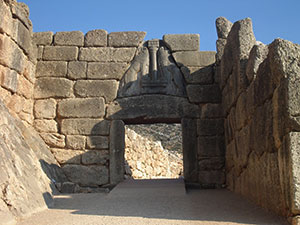
Mycenae is an archaeological site located about 90 kilometres (56 miles) southwest of Athens, in the north-eastern Peloponnese. From the hill on which the palace was located, one can see across the Argolid to the Saronic Gulf. In the second millennium BC, Mycenae was one of the major centres of Greek civilization, a military stronghold which dominated much of southern Greece. The period of Greek history from about 1600 BC to about 1100 BC is called Mycenaean in reference to Mycenae. At its height in 1350 BC, the citadel and lower town had a population of 30,000 and an area of 32 hectares.
Although the citadel was built by Greeks, the name Mukanai is thought not to be Greek but rather one of the many pre-Greek place names inherited by the immigrant Greeks. Legend has it that the name was connected to the Greek word mycēs (μύκης, “mushroom”). Thus, Pausanias ascribes the name to the legendary founder Perseus, who was said to have named it either after the cap (mycēs) of the sheath of his sword, or after a mushroom he had plucked on the site. The earliest written form of the name is Mykēnē, which is found in Homer.
Nafplio
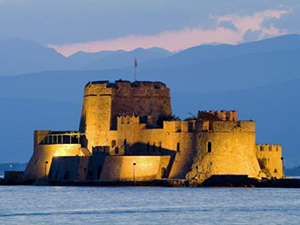
Nafplio is a seaport town in the Peloponnese in Greece that has expanded up the hillsides near the north end of the Argolic Gulf. Most of the old town is on a peninsula jutting into the gulf; this peninsula forms a naturally protected bay that is enhanced by the addition of man-made moles. Originally almost isolated by marshes, deliberate landfill projects, primarily since the 1970s, have nearly doubled the land area of the city.
The town was an important seaport held under a succession of royal houses in the Middle Ages as part of the lordship of Argos and Nauplia, held initially by the de la Roche following the Fourth Crusade and then by Aragonese nobility, before coming under the Republic of Venice and, lastly, the Ottoman Empire. The town was the capital of the First Hellenic Republic, from the start of the Greek Revolution in 1821 until 1834. Nafplio is now the capital of the regional unit of Argolis.
Meet the first capital of Greece with the Frankish, Venetian and Turkish buildings, see the fortified Akronauplia and fortress Palamidi with 999 steps.



No comment